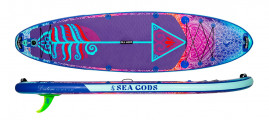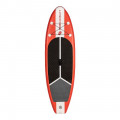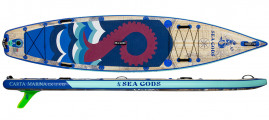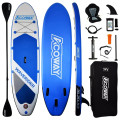Inflatable paddleboards have revolutionized the sport of standup paddleboarding. No longer must paddleboarders lug around and find storage for 10-foot or longer hardboards. For a would-be SUP enthusiast who lives in a condo or drives a compact car, this is a game-changer. The durable construction of high-quality inflatable SUP boards removes any doubt about the performance of blow up paddleboards.
Today, the best inflatable paddleboards boast hardboard performance in supremely portable, accessible and affordable packages. You can choose from inflatable SUPs for all-round recreation and family use, touring, yoga, fishing, whitewater paddling and even surfing.
The popularity of paddleboarding combined with the demand for portable boards has spawned a bewildering number of inflatable SUP brands and designs to choose from. This guide will help you navigate the ever-expanding inflatable paddleboard world.
Whether you’re a beginner looking for buying advice on their first board, or a veteran cruising for an upgrade, we’ll outline everything you need to know to find the best inflatable SUP to meet your needs.
Top picks: Best inflatable paddleboards for 2024
The following inflatable paddleboards have received the highest star ratings by reviewers in our Paddling Buyer’s Guide. See and review all inflatable SUPs here.
Best Inflatable Paddleboards

Wayfarer
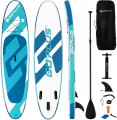
Inflatable SUP 11'
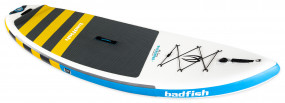
Rivershred
Shop inflatable paddleboards
Many different uses for inflatable standup paddleboards have emerged. Advances in technology and design have allowed different boards to carve out a wide range of niches; inflatable SUP boards exist for yoga, fishing, river surfing, touring, fitness and more. If space is tight, or you’re looking for a board with greater stability and volume for a more forgiving ride, the best standup paddleboard is an inflatable one.
The links below take you to our Paddling Buyer’s Guide, where you can view nearly every inflatable paddleboard on the market, filtered by application, size, store, price and more. Selecting a specific paddleboard shows the important stuff: specs, prices, reviews and where to buy.
Shop by type
Shop by paddlers
Shop by store
Shop by price
Shop by size
8 foot inflatable paddleboards
10 foot inflatable paddleboards
11 ft inflatable paddleboards
12 foot inflatable paddleboards
14 foot inflatable paddleboards
15 foot inflatable paddleboards
34 inch wide inflatable paddleboards
35 inch wide inflatable paddleboards
36 inch wide inflatable paddleboards
Shop by brand
Airhead inflatable paddleboards
Aqua Marina inflatable paddleboards
Boardworks inflatable paddleboards
Body Glove inflatable paddleboards
BOTE inflatable paddleboards
C4 inflatable paddleboards
Hobie inflatable paddleboards
Jimmy Styks inflatable paddleboards
Lifetime inflatable paddleboards
NRS inflatable paddleboards
Pau Hana inflatable paddleboards
Peak inflatable paddleboards
Pelican inflatable paddleboards
Red inflatable paddleboards
Tower inflatable paddleboards
Best inflatable SUPs
Follow the links below to find our articles on specific types of paddleboards. Here, you’ll find relevant buying advice for new and used boards, as well as links to specific boards that we know you’ll love.
Shopping for a used inflatable paddleboard?
Buying used is a great way to save some money on your first inflatable SUP board. Entry-level used inflatable paddleboards enter the market as paddlers upgrade to higher-performance boards. You can also find mid-range inflatable boards secondhand, as more experienced enthusiasts move from all-round models to more specialized boards for fishing, yoga, surfing or touring.
General board buying advice is still highly relevant, and our article How To Buy A Used Paddleboard is a great place to start your research. However, there are also some unique factors for buying inflatables that buyers should be aware of.
Lisa Schell, the managing editor of paddleboarding website, PaddleMonster, points out that a critical thing to look at in a secondhand inflatable is the type of nozzle used to inflate the board. Because of the higher pressures needed to create a rigid-feeling inflatable SUP board, specialized air valves are used.
If the board requires a proprietary pump, ensure that it is included with the sale. Better yet, look for an inflatable SUP with the gold-standard Halkey-Roberts valve (sometimes called an H-Valve). This is helpful if you choose to replace the pump or upgrade to an electric pump.
Inflatable paddleboards are made from durable materials that can take a lot of use (and abuse), but it is possible to damage them. Most damage to inflatable SUPs is the result of improper storage. If the board has been packed away wet or left out in the sun for prolonged periods, mold and mildew, bleaching and deformities should be apparent immediately. Bleaching is a sign of potential UV damage, which can weaken the integrity of the material and compromise its ability to hold air at high pressures.
Deformities may indicate failure of the baffles, or walls, between air chambers. Once these walls fail, the board is finished. Valves can become damaged by sand or other debris; check to ensure the valve opens and closes smoothly, and listen for any air leaking out. A damaged valve may not necessarily be a deal-breaker, as valves can often be replaced.
You’ll want to blow up the paddleboard before buying to complete a thorough inspection. The absolute best way to see if the used inflatable paddleboard is a good fit performance- and comfort-wise is to take it for a test paddle. Schell notes that a great place to do this is at races or symposiums.
Even if racing isn’t your thing, there are boards to try and experts to chat with. New and used boards are often for sale on the spot at reasonable prices.
If you’re buying privately, ask to meet the seller at a location where you can take the board out on the water. Bring your PFD and paddle, and wear appropriate clothing for the water and temperature.
Inflatable paddleboard buying guide
Buying an inflatable paddleboard is like buying any piece of recreational equipment—it is important to understand what you are planning to use it for before setting your heart on a particular model.
If you are wondering, “Should I buy an inflatable paddleboard?”, the first thing to do is figure out what type of paddling you want to do—touring, surfing, fishing, playing around at the lake, or a little bit of everything? If you are not looking to podium any races or carve giant waves, an inflatable paddleboard can be a great match. For speedy racing and fitness paddling, or dedicated ocean and lake surfing, look at specialized hardboard designs.
Follow these general steps outlining how to choose an inflatable SUP and what to look for in an inflatable paddleboard.
Dimensions
Length can be a limiting factor when buying a hardboard if storage is tight. Inflatable paddleboards, which pack neatly into a duffel, don’t have the same issue. You’re free to choose as short or as long of an inflatable board as you prefer. As a general rule, longer boards are faster, while shorter boards turn more readily. Different board designs will also affect the performance—more on that later.
A board’s width is indicative of its stability. Wider boards are more stable, but they also create more drag, slowing the board down.
Inflatable paddleboards are thicker than their rigid counterparts due to their construction. Most inflatables you’ll find are 5” or 6” thick. Five-inch-thick boards keep the paddler’s center of gravity lower, giving them a more stable feel. Six-inch-thick paddleboards have a higher weight capacity, and may make the board feel more rigid. Opt for the thicker option if you’re looking at a longer board or want the extra capacity.
Speaking of capacity, volume is the last dimension to consider. Volume is simply how much air is in the inflatable, measured in liters. It’s an important factor in determining how stable the board is at a glance. Higher volume boards will have more buoyancy and a greater weight capacity—something to consider if you plan on paddling with your kids or dog, or want to pack a pile of gear for a longer trip. Low volume paddleboards handle better in surf and on waves.
Categories
All standup paddleboards are not created equal. Different categories of paddleboards correspond with various paddling styles. Some of the most popular types of boards are all-around, touring, yoga, fishing, surf and whitewater boards.
All-around paddleboards are a good choice for generalists who might want to do a bit of everything. These boards balance stability and speed, and typically have a rounded surf-style nose and planing (flat) hull that glides smoothly atop the water. They land between touring and surf paddleboards in length, typically 10-12 feet.
Touring paddleboards are built for covering lots of distance, and are the fastest and most efficient to paddle. They have a pointed nose and displacement (V-shaped) hull, which cuts through water rather than skimming across it like a surf-style board. For overnight or multi-day trips, these boards may have D-rings for attaching gear. These will be some of the longest boards you’ll find, typically 12-14+ feet.
With yoga paddleboards, stability is key. On-water yogis don’t plan on traveling far, but rather staying dry and feeling stable throughout their practice. Paddleboards designed for SUP yoga have lots of width, a flat planing hull and a cushy, oversized deck pad for sun salutations and restful shavasana.
Fishing paddleboards are also designed with an emphasis on stability. Anglers on a paddleboard want to catch fish, not join them in the drink. These boards are essentially paddling platforms that are stable enough for the angler to move around as they cast and haul in fish. Fishing paddleboards may have tie-downs for securing cooler and tackle, as well as mounts for rod holders. You can also look for fishing paddleboard/kayak combos, which merge the efficiency of a kayak with the higher vantage of a standup paddleboard.
Surf paddleboards are shorter than most other boards, with a rounded, upswept nose and flat, planing hull. They turn quickly to catch waves and carve while on them. They are generally 11 feet or less, with shorter boards being much more maneuverable.
Whitewater paddleboards are similar in design to surf paddleboards, but the key difference is that inflatable boards dominate this category. Air-filled boards are much more impact-resistant if you collide with submerged rocks, bending rather than breaking. An inflatable board is also more forigiving to fall onto, something you’ll be doing a fair bit of when mastering whitewater on a SUP!
Answers to commonly asked questions below provide more info on inflatable SUPs.
-
What is an inflatable standup paddleboard?
An inflatable standup paddleboard is a portable paddleboard that stores in a compact duffel and needs to be filled with air before use. The paddler pumps the board up with either a hand pump or an electric pump before each use.
Durable, flexible materials combined with specialized sewing techniques like drop-stitching allow inflatable boards to hold their shape, resulting in a high-performing, responsive board that can be rolled up after use and stored in a closet.
-
Are all paddleboards inflatable?
Not all paddleboards are inflatable; rigid paddleboards—or hardboards—are another popular option. Hardboards are constructed from epoxy, foam, plastics, fiberglass, wood, bamboo or other composite materials.
-
Are inflatable paddleboards good?
Inflatable paddleboards are an excellent choice for most recreational users. They are generally stable and forgiving, so they excel as beginner boards for light touring, river paddling and beginner surfing. The portability of an inflatable paddleboard is a massive benefit for anyone who is tight on space or is looking for an easy-to-transport SUP.
Inflatable paddleboards are not for everyone; serious surfers and racers will appreciate the enhanced efficiency, speed and agility that comes with specialized solid boards.
-
Are inflatable paddleboards safe?
Inflatable paddleboards are as safe as any other board if used correctly. This includes inspecting the board before use and after impacts to check for air leaks. Good quality inflatable paddleboards are made from robust, puncture-resistant materials. Many inflatable paddleboard designs incorporate multiple air chambers so the board will not deflate entirely in the event of a puncture.
Safety with any paddlesport begins with wearing a properly fitting Personal Flotation Device (PFD) and only paddling in conditions appropriate to your skill level and equipment. An ankle leash is an essential piece of safety equipment that should be worn while paddleboarding: a secure leash prevents the board from drifting out of reach should you fall off into the water.
-
Inflatable paddleboard vs solid
The advantages of an inflatable paddleboard relate to the portability and use of the board. For paddlers who are tight on storage space and/or want a board that is easy to transport to and from the water, inflatable standup paddleboards are ideal. They pack easily into a duffel and can be stored in a small closet or the trunk of a car.
For an all-around paddleboard, an inflatable SUP is an excellent choice for beginner paddlers as the deck (top) of the board is softer and more forgiving than a solid hardboard should you accidentally fall on it. This also makes inflatable paddleboards a great fit for SUP yoga and kids or family paddlers.
Compared to solid hardboards, inflatable paddleboards actually offer equal or even greater durability. An inflatable SUP board will bounce off rocks and flex on impact, while solid paddleboards can crack or dent on impact, depending on the materials they’re made from. Proper storage is key to the longevity of any paddleboard, but you’ll want to be especially careful that inflatable boards are dry and clean before being folded away for storage.
Performance-wise, a hardboard has the edge for anyone who is looking to do serious paddleboard surfing or racing. Solid boards flex less than inflatables, resulting in better efficiency, responsiveness and glide, so these boards excel in high-performance situations where speed and agility are important.
Surfers also prefer rigid boards because they can be made thinner, allowing for greater maneuverability so the board can “carve” (perform sharp turns and cutbacks) on waves.
-
Where to buy inflatable paddleboard
Inflatable paddleboards are available just about anywhere paddling equipment is sold. You’ll find the cheapest inflatable paddleboards at big-box department stores and online at Amazon; these are suitable for casual paddlers on sheltered waters. Shop at outdoor box stores for better quality entry-level boards, or head to a dedicated paddlesports shop for premium boards from the best inflatable SUP brands.
There are also opportunities to buy inflatable SUP boards direct from suppliers through the links in the Paddling Buyer’s Guide. Find used inflatable boards through general classifieds like Craigslist, Facebook Marketplace or Kijiji. Specialized classifieds like MEC Gear Swap and Paddlemonster.com are also good places to find quality used paddleboards.
-
How long do inflatable paddleboards last?
An inflatable paddleboard’s durability is dictated by who builds the board and how you treat it. Unless you’re just looking for a cheap, casual toy for occasional use at the beach or cottage, we recommend buying inflatable paddleboards from established companies with a history of producing quality paddleboards (rigid and inflatable). These companies will have better quality control and superior materials and construction; if something does go wrong, your investment is backed by a solid warranty. How the board is treated and stored also determines how long the paddleboard will last.
With proper storage, an inflatable board can last years, but improper care significantly affects the lifespan of an inflatable SUP. Boards should not be left out in direct sunlight, especially when inflated (hot air expands, increasing air pressure and potentially “popping” your board), and the board should always be allowed to dry completely before storage. Ironically, inflatable boards are best stored semi-inflated long-term.
While this would seem to defeat the purpose of a board that can be stored in a duffel, the best solution is to periodically take the board out and inflate it. This prevents damage that can result from constant pressure on folds and creases.
-
How sturdy are inflatable paddleboards?
Inflatable paddleboards feel very sturdy when they are inflated to their recommended air volume. This is listed in PSI (pounds per square inch), typically between 12-18 PSI. Inflating to the recommended air volume is essential as it is the pressure at which the board performs the best.
This is the “sweet spot”; when the paddleboard feels the sturdiest while not putting excessive strain on the seams and material. Every blow up paddleboard is different, so be sure to consult the manual before inflating.
-
Cost of inflatable paddleboards
Entry-level inflatable paddleboards often cost less than comparable rigid boards. Expect to pay a minimum of around $700 for a quality new inflatable board. Many cheaper inflatable paddleboards can be found, especially through online marketplaces like Amazon, but there is the risk of poor construction or limited durability.
Additionally, the benefit of talking to an expert or company representative to answer questions that may arise is lost when buying online. While there may be some great cheap deals out there, you run the risk of only getting what you pay for. A few extra dollars initially will save money down the road.
-
What are inflatable paddleboards made of?
Inflatable paddleboards are made with some combination of PVC vinyl. This rubber-like material is impact-resistant and durable. The top (deck) of the board may have foam or rubber pads to add comfort and grip, and bungees (stretchy cords) for on-deck storage. Fins, which help the board paddle straight, are made from either plastic or soft silicone rubber, with the softer ones being more resilient to damage from underwater objects.
-
Inflatable paddleboard material
While most inflatable paddleboards are made with some combination of vinyl, plastic and fabric, there are key things to look for in a quality board. “Single-layer” drop stitching is most common in cheaper boards, as this construction style saves on cost and weight. It is less durable and may be more prone to quick wear.
“Dual-layer” construction adds another layer of PVC vinyl, adding protection to the board. The boards are heavier and more expensive due to the extra material, but have more rigidity and perform better overall.
Most higher-end inflatable paddleboards are made with a “fusion” layup. Think of this as an intermediary between single- and dual-layer boards. In a fusion constructed board, the drop-stitched fabric has a layer of plastic coating fused to it. These boards cost less than dual-layer paddleboards but have more rigidity, durability and better performance than single-layer boards.
Unfortunately, online retailers often throw “fusion-construction”, “military-grade” or other buzzwords around haphazardly, so beware of any grand claims made regarding construction and performance. The best option is to talk to experts at your local paddlesports shop, or board owners themselves, and if you can, try the board before you buy it.
-
Are inflatable paddleboards good for beginners?
Inflatable paddleboards are ideal for beginners as they are forgiving and easy to learn on. Most inflatables offer beginner-friendly dimensions: Beginner boards are wider, typically at least 30 inches at the widest point, and thicker with higher volume for enhanced stability.
Bigger boards feel more stable and allow beginners to master the basics quickly. An inflatable is an excellent introduction to the diverse world of standup paddleboarding. As users progress, they may find themselves upgrading to high-performance, rigid boards.
-
Do inflatable paddleboards lose air?
If left inflated for a long time, an inflatable SUP board will lose air. This happens due to pressure changes, especially when temperatures fluctuate. Always check your board before using it, and add additional air as needed. Best practice is to check and top the board up before each paddle if it needs air. When you’re out on the water, a quality inflatable paddleboard should not leak or lose air.
-
Inflatable paddleboard weight limit
An inflatable paddleboard’s weight limit depends on its size and volume. A bigger paddleboard with more volume has a higher weight limit. The weight limit varies greatly from board to board, so be sure to consult the manufacturer’s specifications to find the weight limit for a particular model. Where suggested weight ranges are given, this is a useful tool for selecting an inflatable paddleboard that is sized appropriately for the paddler.
-
Will my dog pop an inflatable paddleboard?
Most inflatable paddleboards are robust enough that paddlers can bring their dogs along without worrying about Fido’s toenails (or teeth) popping the board. Low-grade or knock-off paddleboards may not be as durable, so research the manufacturer and always read reviews before buying a paddleboard. If you know you want to paddle with your dog, look for a board with rubber or foam pads on the deck (top) of the board. This will be more comfortable for both your feet and your dog.
-
How are inflatable paddleboards made?
Inflatable paddleboards are made using a construction technique called drop-stitching. Drop stitching uses thousands of fine threads to connect two pieces of material together. The length of the threads determines the dimensions of the resulting air chamber, as well as its shape. The result is a strong bond between the two materials, which helps them hold their shape, even when fully inflated. Drop stitching is not only used on paddleboards; inflatable aircraft wings employ the same process.
-
How heavy is an inflatable paddleboard?
Inflatable paddleboards are often lighter than their solid counterparts. Expect an all-around inflatable standup paddleboard to weigh in the range of 20–28 pounds. The outfitting (bungees, deck pads, tie-downs, etc) and more rugged construction may add weight, but these can be valuable features for added durability, performance or storage options.
-
How much weight can an inflatable paddleboard hold?
Inflatable paddleboards can hold a significant amount of weight, but each board will have a recommended range specific to that model. This weight limit depends on the overall volume of the inflatable SUP, which is a product of the board’s length, width and thickness. The longer the board, typically the more weight it can handle. Consult the product details to find a size guide for specific paddleboards.
-
How stable are inflatable paddleboards?
Inflatable standup paddleboards are generally very stable. A board’s stability is relative to its width and thickness. A wider, thicker paddleboard will feel more stable than a narrow or thinner paddleboard. Since most inflatable SUP boards are thicker and often wider than their rigid counterparts, these stable boards are excellent for beginners.
-
What size inflatable paddleboard?
The type of paddling you are planning to do dictates the size of paddleboard you need. A common mistake for beginners is to buy their paddleboard too short. Many assume that a smaller board will be easier to handle for a new paddler; however, longer boards track (travel straight) much better, making paddleboarding more enjoyable since you’re not constantly correcting or turning to stay on course.
For an all-around inflatable board, 11’6” is a good minimum length. For surf or river paddling, look for a shorter board that is easier to turn. Width varies by model, but the wider the board, the more stable it is.
-
Can I put an inflatable SUP on a roof rack?
Once it’s pumped up, an inflatable SUP board can be transported on a roof rack, but be sure to check the conditions before driving. In heavy winds, they may be a hazard, especially if the board is not adequately secured. In some instances, it may be best to transport the inflatable SUP in its duffel and blow up the paddleboard at the put-in.
-
How hard is it to inflate a paddleboard?
Most inflatable standup paddleboards come with a manual hand or foot pump, and pumping the board takes as little as 10 minutes. It is a bit of work, but consider it a warm-up to your paddling session! Dual-action pumps are more efficient than basic single-action pumps, using both the pushing and pulling motions to add air into the board. For easier and faster inflation, opt for an electric pump.
-
Should you leave a paddleboard inflated?
A paddleboard can be left partially inflated when not in use. Boards should never be left fully inflated, especially in areas where the temperature fluctuates greatly. As the air inside the board warms, it expands. If the board is fully inflated, the expanding air puts excessive pressure on the seams and baffles (interior walls that create the air chambers), potentially leading to damage.
-
Can you surf on an inflatable paddleboard?
Using inflatable paddleboards for surfing is best for beginners on smaller waves. Inflatable paddleboards do not duck-dive easily, meaning you can’t push the nose of the board underwater to escape a battering from a breaking wave. Furthermore, the performance of an inflatable board doesn’t compare to a hardboard for surfing. A key feature of a solid paddleboard shaped for surfing are the rails (edges of the board, where the bottom meets the sides), which allow paddlers to carve turns on waves easier.
With its thicker shape and rounder rails, an inflatable is fine for someone new to surfing, but you’ll want a solid board as you progress from riding whitewash to making turns on larger waves. An important exception is river surfing, which is best on an inflatable board, as the material is more forgiving for impacts on submerged rocks.
Inflatable paddleboard reviews
Paddling Magazine is your best online resource for inflatable paddleboard reviews. Remember, the first step in choosing a board is considering the type of paddling you aspire to do. Paddleboards vary significantly across brands, and many are niche performers. Reading expert reviews will allow you to evaluate how each inflatable SUP handles and how it performs for the intended paddler and conditions.
- Inflatable Paddleboard Review: ISLE Pioneer 2.0
- Inflatable SUP Review: BOTE Rackham Aero 12’4”
- Inflatable Hybrid Review: TAHE Beach SUP-YAK
- Inflatable Paddleboard Review: Red Paddle Co 11’3” Sport
- Hobie Mirage i11S Inflatable Kayak-Paddleboard Hybrid Review




